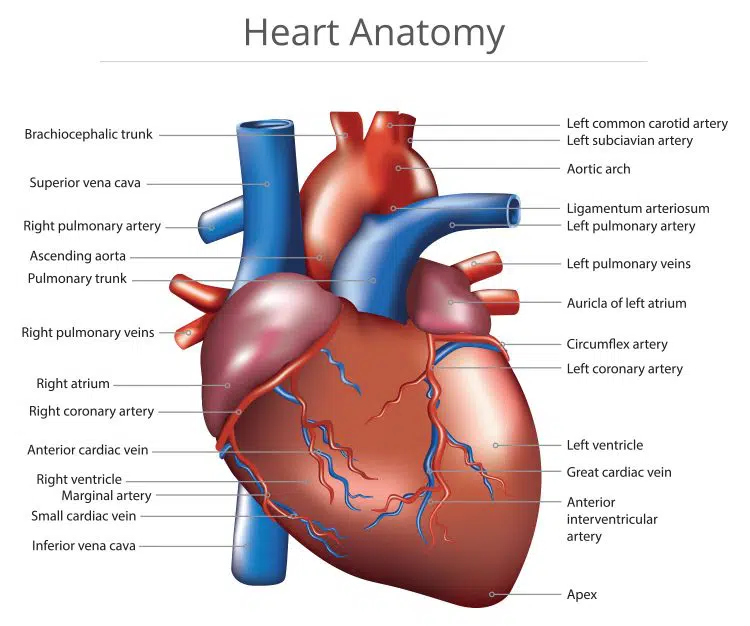Calculate Your Target Heart Rate
Use the target heart rate calculator to find your heart rate zone during physical activity.
Knowing your ideal heart rate zone and aiming for this range is recommended for optimal performance and health. The ideal heart rate can vary between individuals due to several different factors.
keep reading to learn more about this handy heart rate tool.
Why is Your Target Heart Rate Important?
The intensity at which you perform a physical activity is an important component of getting in shape, achieving your performance goals, or engaging in physical movement, in general.
Johns Hopkins cardiologist Seth Martin, M.D., M.P.H. defined target heart rate zone perfectly in simple terms… “Think of it as the “sweet spot” between not exercising hard enough and overexerting.”
Benefits of aiming for a specific heart rate zone include:
Level Up Your Fitness: Join our 💪 strong community in Fitness Volt Newsletter. Get daily inspiration, expert-backed workouts, nutrition tips, the latest in strength sports, and the support you need to reach your goals. Subscribe for free!
Improving cardiovascular endurance and overall fitness
To build up your cardio fitness, especially if you want to get better at one or various faster-paced activities, you will have to turn up the intensity and keep it there for the required duration.
Conditioning comes from building up the heart and gradually increasing activity.
“A higher heart rate is a good thing that leads to greater fitness,” says Johns Hopkins cardiologist Michael Blaha, M.D., M.P.H.
Your goals, what you’re trying to achieve, or the effort you are willing to put forth all play a role in how you approach your activities.
Keep in mind though, that, as with anything, if you want to get better at something, you have to be consistent and approach your activities based on your specific goal/s, also known as specificity.
Not everyone is interested in doing super-intense workouts. For some, a short and light jog, fast walking, or maybe even a rope jumping session is more appealing.
Each activity involves a level of intensity and you can ensure you’re getting the most out of your efforts by monitoring and maintaining your heart rate.
Prevent overstressing your heart
When it comes to physical fitness, not everyone is at the same level. In other words, you are not going to be able to run as far as a long-distance runner in the same amount of time if you don’t train for it.
But then there are things like medical conditions that prevent some people from being able to do very high-intensity activities or exercises/workouts.
That’s why it’s recommended to have an idea of your optimal heart rate range and aim to perform somewhere within that zone.
Burn calories and lose fat
While we burn calories by just breathing and doing regular everyday tasks, if your goal is to drop several pounds in a reasonable time frame, exercising with decent intensity will dramatically speed up the process.
Of course, you could simply eat fewer calories and not exercise to lose weight, but then you won’t get the benefits of exercise.
Moving your body at a decent intensity and sustaining this as part of a normal routine will help you to burn more calories following exercise, also known as excess post-oxygen consumption (EPOC).
Plus, activity helps to stave off disease and keep your body healthier which plays an important role in weight management.
Really, there are many benefits of being active.
Resting Heart Rate
Before you’re able to calculate your target heart rate, you must first know your resting heart rate or the number of times your heart beats per minute when your body is in a resting state.
The fitter you are, the lower your resting heart rate will be on average because your heat doesn’t have to work as hard.
But other factors such as age, medications, etc can also affect resting heart rate.
If you are not sure how to take your pulse, don’t worry, it’s simple. There are a few different ways that you can check your heart rate.
Here are the different common methods to measure your pulse or heart rate:
- Place your index and middle finger on the inside of your opposite wrist against the radial artery and count the number of pulses per minute.
- Place your index and middle finger on the neck against the carotid artery and count the number of pulses per minute.
- Use a heart rate monitor/device or fitness tracker.
- Use RPE (rate of perceived exertion) to estimate how you feel based on your intensity during physical activity.
To take your pulse at the radial artery:
If using the index and middle fingers of the left hand on the right wrist
- Place the tips of your index and middle fingers just below the crease of your wrist on the right side of the forearm tendon.
Count the numbers of pulses in one minute and that is your resting heart rate.
If using the index and middle fingers of the right hand on the left wrist
Level Up Your Fitness: Join our 💪 strong community in Fitness Volt Newsletter. Get daily inspiration, expert-backed workouts, nutrition tips, the latest in strength sports, and the support you need to reach your goals. Subscribe for free!
- Place the tips of your index and middle fingers just below the crease of your wrist on the left side of the forearm tendon.
Count the numbers of pulses in one minute and that is your resting heart rate.
How To Use The Target Heart Rate Calculator
Using this handy tool is very simple. Although, again, you must first know what your resting heart rate is for the most accurate calculation.
Here are the steps to use the calculator.
- Determine your resting heart rate as mentioned previously and then input the result.
- Provide your age
- Hit Calculate
The Results
Now it’s time to evaluate your results and explain how the calculator works.
The target heart rate calculator estimates two things: Maximal heart rate and intensity – target heart rate. You’ll be provided with these values after you hit calculate.
Maximal heart rate is defined as the greatest number of beats your heart can do during physical activity.
To find your maximal heart rate using the traditional method (also the method used by the calculator), subtract your age from 220.
So, for example, let’s say you’re 29 years old. You’ll subtract 29 from 220.
220 – 69 =191
Your maximal heart rate is 191.
Intensity – target heart rate is an estimate of target heart rate range expressed using percentages of your maximum heart rate (e.g., 50-55%, 60-65%, 70-75%, 80-85%).
The calculator uses the Karvonen or heart rate reserve (HRR) formula to find the target heart rate range.
Karvonen formula = maximal heart rate – resting heart rate x intensity level in percentage + resting heart rate.
First, you have to find HRR. To do this, subtract resting heart rate from maximal heart rate.
So, using the same example from before, you’ll take 191 (max heart rate) and subtract 68 (resting heart rate).
191 – 68 = 123
Your HRR is 123.
The Karvonen formula takes HRR and multiplies it by a percentage range of physical activity intensity. So, let’s use the lower end of 50-55% intensity as an example.
123 (HRR) x 50% or .50 (intensity) = 61.5
The last step is to add the resting heart rate.
61.5 + 68 – 129.5 beats per minute (bpm)
Using the example of a 29-year-old with a maximal heart rate of 191, the target heart rate at 50% intensity is 129.5 bpm.
What Are The Best Activities To Get Your Heart Rate Up?
While physical activity is very much a preference-based category, we can certainly recommend workouts and methods that’ll get your heart pumping.
Here’s a list of great activity choices with lots of great information and pre-planned workouts that you can try.
- High-intensity interval training
- Steady-state cardio
- Circuit training
- Powerlifting programs
- Calisthenics training
- Complexes
- Tabata workouts
- Jumping rope
- Short and intense workouts
- Prison workouts
- MMA workouts
- Metcon (metabolic conditioning) workouts
- EMOM (every minute on the minute) workouts
- Viking workouts
- Zombie apocalypse training
- Assault bike workouts
- Workout games
- Walking at a brisk pace
- Sports
- Whatever physical activity you enjoy doing!
You can also learn how to structure your own workouts using this helpful guide.
Wrapping Up
Well, there you have it! By paying attention to your heart rate during physical activities, you’ll ensure that your efforts are not in vain.
While the heart rate calculator will help you find your target heart rate zone, fitness trackers or pulse monitoring devices are great tools to ensure your heart rate is within the ideal range.
To get results, you should be training with appropriate intensity and consistently. You don’t want to do too little but you also want to be sure that you are not pushing yourself too hard as this is unhealthy.
We hope you found this calculator and information helpful for your active lifestyle!









